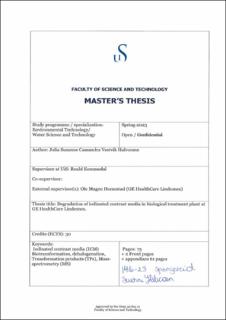| dc.description.abstract | Iodinated contrast media (ICM) are used all over the world.
Side streams form production ICM containing acetate (90 %), solvents (methanol, acetone, 2-Methoxy ethanol, and isopropanol) and ICM are treated by a biological treatment plant combining anaerobic extended granule sludge bed (EGSB) technology with an aerobic moving bed bioreactor (MBBR) as polish step.
Samples from the three anaerobic EGSBs and aerobic CFIC reactor was analyzed by ion -chromatography and HPLC with UV-detector coupled with a single-quadrupole mass-specter (MS). Reduction of iohexol in EGSBs were 96-98 % and 100% for iodixanol and intermediates. ICM was not detected in samples after aerobic MBBR reactor.
25 TPs was detected from EGSB 1 and 2, whereas 15 TPs was detected in samples form EGSB 3 using full scan-mode with mass range 150-1600 m/z. Differences in biological community between EGSB 1 and 2 compared to EGSB 3 was observed, may be the reason for differences in TPs. In samples form aerobic reactor (CFIC) 8 TPs was detected.
Free iodide increased from 16 mg/L to 85 mg/L (EGSB 1), 80 mg/L (EGSB 2) and 55 mg/L (EGSB 3). Free iodide did not increase after CFIC. Indication that reductive dehalogenation only occurred in the anerobic reactors. TP 694, TP 451, and TP 366 related to deiodinated ICM was detected in all EGSBs. Only TP 451 was detected in CFIC. Four known iohexol TPs (TP 833, TP 775, TP 657 and TP366) from literature was detected using single-ion mass (SIM) scan-mode.
New TPs (TP 459, TP 711, TP 342, and TP 585) of iohexol was detected in the EGSBs. Suggestive structure for four of the TPs was drawn. Deiodination by addition of hydroxyl group was suspected. TPs detected in CFIC was not detectable by the UV-detector, indicating possible breaking of the aromatic-ring structure of the ICM.
The study showed that the efficiency of the biological treatment plant at GE HealthCare has changed drastically since 2020. The complexity of observed TPs is a result of the presence of other impurities from production that form TPs in addition to those formed from intermediates, iohexol and iodixanol.
Dehalogenation and subsequent degradation by oxidative aerobic processes was confirmed. Treatment with activated carbon was shown to be an effective way to remove TPs from CFIC effluent, while treatment with Ion-exchange resin was less efficient. | |
